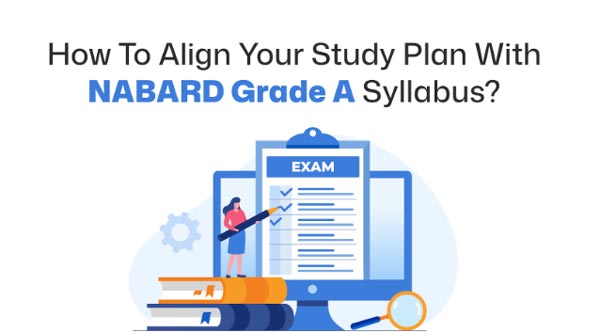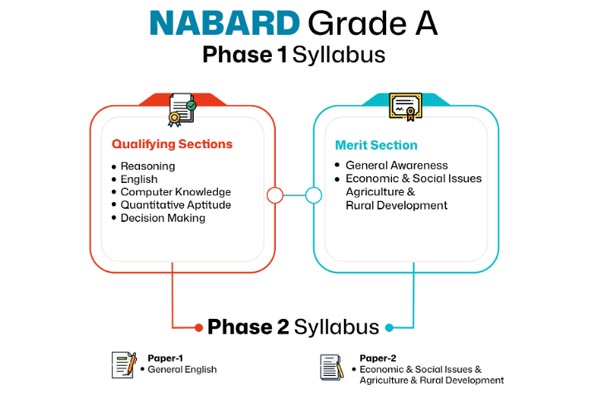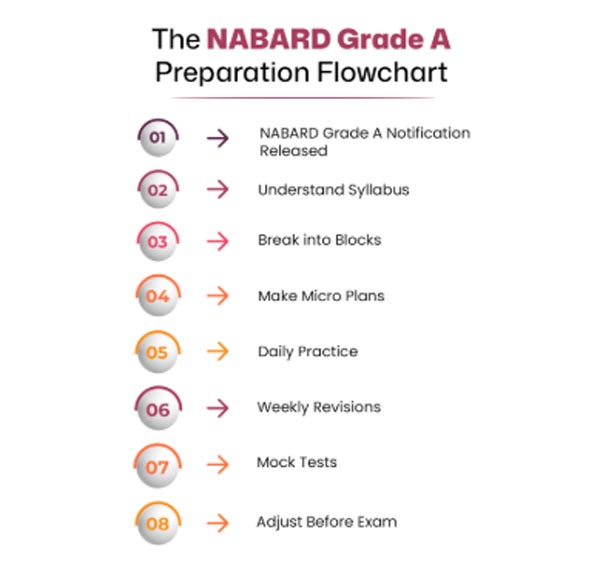
How To Align Your Study Plan With NABARD Grade A Syllabus?
Whenever you are planning to prepare for any government exam, the first thing that comes to your mind is to create a study plan just for that exam. The same is the case with the NABARD Grade A exam, even though the NABARD Grade A notification has not been announced yet, I know many of you are either looking at it as your dream exam or as a backup exam. Either way, you will have to create a study plan for the exam.
But here’s a question that often gets ignored: Is your study plan truly aligned with what is needed for the NABARD Grade A exam?
Without a proper study plan, all the hard work can feel scattered. You end up covering random topics while ignoring important areas. Most of you feel overwhelmed, not because the syllabus of NABARD Grade A is too difficult, but because they do not know where to start and how to organize their preparation. Some students try to cover everything but still miss crucial topics, while others skip important subjects unknowingly.
To escape these types of problems, you need to get a better understanding of the NABARD Grade A syllabus. Once you know what is expected of you, planning becomes easier.
Let’s understand the NABARD Grade A syllabus!
Understand The NABARD Grade A Syllabus Fully Before Planning-
The first step in aligning your study plan is to read and understand the syllabus line by line. The NABARD Grade A exam is divided into two phases, which are then followed by an interview.
Many students make the mistake of assuming that the syllabus is similar to other exams, and it is not entirely wrong. But NABARD has its own unique demands as well. For example, ARD requires you to study topics related to Indian agriculture, rural economy, and government schemes, which you may not find in regular banking exams.

Break The Syllabus Into Blocks-
Now that you know the NABARD Grade A syllabus, the next step is to break it into smaller, manageable parts. If you try to study everything at once, it quickly becomes overwhelming. Instead, divide your preparation into weekly and monthly goals.
For example, you can dedicate two weeks entirely to ARD basics, followed by a week for ESI fundamentals. To understand ESI better, you can even take RBI Grade B quizzes. This way, you are not only covering the syllabus but also giving enough time for understanding.
Breaking your study into blocks also allows you to track your progress. You will know exactly what has been completed and what needs attention. This makes your preparation organized and less stressful.
Balance Static And Current Affairs-
The NABARD Grade A exam gives equal importance to static subjects and current affairs. Static subjects include your ARD and ESI theory portions, while current affairs involve recent developments, government schemes, RBI notifications, reports, and budget updates.
It is important to read newspapers daily, follow PIB releases, and refer to reliable current affairs compilations. But you should also ensure that you are not spending your entire day reading current affairs only. A balanced plan will allow you to study static topics in the morning and current affairs in the evening. This combination helps keep your preparation relevant and fresh.
Make Subject-wise Micro Plans-
Each subject in NABARD Grade A requires a slightly different approach. For Quantitative Aptitude and Reasoning, daily practice of questions and regular mock tests are helpful. For English, reading editorials and writing practice essays improve both your vocabulary and writing speed.
ARD and ESI require you to make detailed notes. ARD especially demands that you understand topics like soil health, irrigation, cropping patterns, and government schemes for farmers. ESI will cover topics like inflation, monetary policy, poverty, unemployment, and social sector programs.
Revision And Practice Sessions-
Studying once is not enough. Revision helps you retain what you have studied. Set fixed revision days in your calendar. You can revise one subject every week or allocate two hours every Sunday for complete syllabus revision. Weekly revisions keep your memory fresh and also reduce exam-day anxiety.
Mock tests and quizzes will play the most important role in your NABARD Grade A preparation. Attempt full-length mocks regularly and analyze your performance. This helps you identify weak areas early and allows you to work on them before it gets too late.
Adjust As The Exam Comes Closer-
No study plan is perfect from day one. As the exam approaches, you will get a clearer idea of which subjects need more work. Modify your plan accordingly. If your Quant scores are consistently low, allocate extra practice sessions for that. If you are confident in ESI, reduce its time and shift focus to ARD.
Also, as Phase 2 of the NABARD Grade A exam comes closer, increase your practice for descriptive answers. Writing answers under time limits will help you improve both your speed and structure.

Final Thoughts-
Aligning your study plan with the NABARD Grade A syllabus is not about studying harder but studying smarter. The nabard grade a notification gives you the official starting point, but how you plan after that makes all the difference. When you break the syllabus into blocks, balance theory and current affairs, make subject-wise plans, revise regularly, and adjust smartly, your preparation becomes solid.
Remember, thousands of candidates prepare every year, but only those who follow a clear, well-aligned plan succeed. Your job is to stay consistent, track your progress, and keep your strategy flexible. This exam is tough, but not unbeatable.

